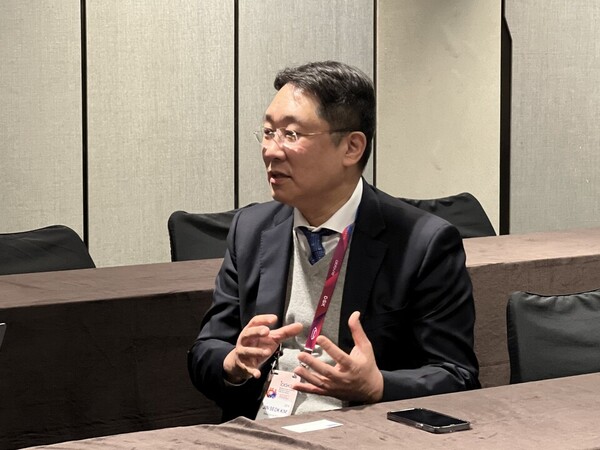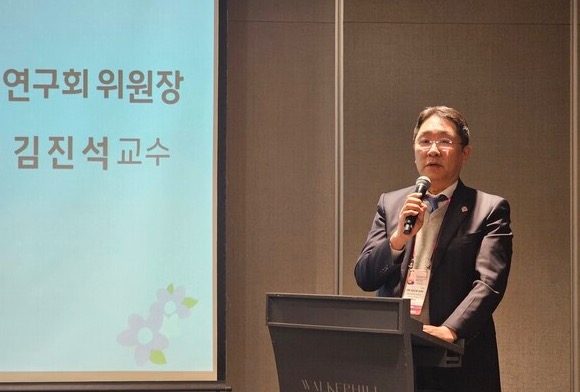The treatment landscape for multiple myeloma is much better than in the past, with improved patient survival rates. However, many challenges still need to be addressed. The International Myeloma Foundation's Global Myeloma Action Network (GMAN) declared March 30 every year as “Multiple Myeloma Day (MM Day)” to improve patient rights and support treatment.
The Korean Multiple Myeloma Working Party (KMMWP), the Korean Society of Hematology, and the Korean Blood Disease and Cancer Association (KBDCA) held an MM Day campaign and commemorative event on March 29 at the Grand Walkerhill Seoul. This year's event was held under the slogan, “Flowers of Hope, Let's Bloom Together,” and was organized as a bouquet campaign. Korea Biomedical Review met with Dr. Kim Jin-seok (Department of Hematology at Severance Hospital), chairman of the Korean Multiple Myeloma Working Party, to learn about the current status of multiple myeloma treatment in Korea and future challenges.

Q: You premiered the Multiple Myeloma Fact Check video at today's event. Can you explain what it is about?
A: We collected questions that patients usually ask and prepared a Q&A in advance, and we decided to make a video to show them. Every year, at the end of October, we can meet with patients offline. Once a year, about 200 to 300 people gather to hear a short lecture and take questions. We will show the movie here.
Individual hospitals also have time for education about multiple myeloma, but it's hard to get enough time in our healthcare environment. Patients will feel much more comfortable coming to an event like this and learning the basic concepts.
Q: What other activities are you planning for the working party?
A: We have activities with patient organizations, but it is important to have our independent academic activities. Doctors are not the only ones who see patients. There are many nurses, especially research nurses, nurse practitioners, and recently, nurse specialists. So, we created a program to educate them.
Since August last year, we have been holding a one-day lecture called the Multiple Myeloma Forum. This forum brings together junior staff, specialty nurses from each hospital, and research nurses. We are very serious about this training program because we believe patients can be better cared for if they have specialized knowledge and work properly.
Treating multiple myeloma is not something that doctors alone can do. We need to involve young doctors and fellows because we can't see the patient every minute. Focusing on the education of young doctors and nurse practitioners improves the quality of care. The first event was very successful last year, so we are preparing for this year's event in August.
Q: What challenges are medical professionals and patients facing in Korea’s clinical field?
A: There are many challenges. In particular, new drugs, such as antibodies and CAR-T therapies, are too expensive to be easily imported into Korea, and patients have many complaints about this.
The government needs to solve this problem quickly, but it is difficult for the government to license all drugs because the cost of one year of treatment is about 300 million won ($204,080). Insurance coverage is also limited, so foreign companies cannot easily lower the price of drugs.
Compared to Japan, Korea has much less access to new drugs. Although Japan and Korea have similar GDPs, there is a huge difference in access to new drugs. The government policy itself does not spend enough national resources on health insurance and tends to rely on doctors' efforts to solve people's health problems. No matter how hard we try, we can only treat patients well if we have good drugs, and there are difficulties between the limitations of health insurance and the high cost of new drugs.
Q: What policy and institutional improvements are needed to improve the treatment environment for multiple myeloma?
A: The biggest problem is the lack of training for junior doctors. Young doctors don't want to choose hematology because they see us struggling. Compared to other cancers, blood cancers have a higher hospitalization rate and are more severe. Infections and pneumonia are very painful, and when young doctors see professors struggling with no trainee doctors and fellows, it makes them more reluctant.
We are overcoming this by replacing nurses, but the role of doctors cannot be completely replaced. If not now, something horrible could happen in 10 years. If we can't treat multiple myeloma in Korea, we may have to go to Japan.
If you try to fix it by then, you may be unable to practice. To become a hematologist, you must train for at least 10 years and can't invest 10 years later. The challenge is to create incentives for young doctors to be interested in and choose to specialize in high-risk diseases.

Q: We've heard that there are also issues with reimbursement of diagnostic technologies, including MRD (microscopic residual disease) testing.
A: MRD testing is too expensive. It costs about 600,000 to 700,000 won per test, and only about 10 percent is reimbursed. This test is important for treatment strategy. If the MRD is negative, medication can be reduced, and if it's positive, treatment can start sooner.
The government reimburses 95 percent of the tests for patients with other cancers, but multiple myeloma patients only get 10 percent. These important tests are a small part of the overall cost of treating cancer patients, so it's important to be realistic about reimbursement. This is especially important in hematologic cancers, where the concept of MRD is well established and can change the direction of treatment.
Q: What is your message to patients?
A: Don't lose hope; work hard with your healthcare team. It's essential to be honest about your financial situation and difficulties and to trust your healthcare team. Not every patient can afford a drug costing 30 million won a month, so exploring other options and clinical trials is essential.
The most important thing is standardizing all treatments; it is not necessarily that you get good treatment in Seoul, but you get the same quality of treatment everywhere. Many patients have the misconception that they can only get good treatment at large hospitals in Seoul. However, Korea has a national health insurance system, and medicines are used to the same standard everywhere. Patients should see their doctors frequently at their regional hospitals and get a quick response when problems arise.
Finally, I would like you to trust and follow experts' opinions. The government, the public, patients, and patient organizations will be more receptive to experts' opinions. We (doctors) are not advocating for the use of expensive drugs, but we are trying to treat patients cost-effectively as part of the public. If each party cooperates with one another based on trust and respects the opinions of experts, we can achieve better results with the same resources.
Related articles
- [ICKSH 2025] ICKSH expands beyond Asia, attracts experts from US and Europe
- [ICKSH 2025] Paroxysmal nocturnal hemoglobinuria drug Empaveli targets extravasation hemolysis
- [ICKSH 2025] Korean hematologists urge faster reimbursement for lifesaving blood cancer drugs
- [ICKSH 2025] CAR-T therapy reshapes lymphoma treatment amid new strategies and resistance challenges
- [ICKSH 2025] ‘Don't let treatment kill the patient before the disease does’: Mayo Clinic doctor
- [ICKSH 2025] ‘Ph-like ALL treatment paradigm shifting toward molecularly guided immuno- and targeted therapy’
- [ICKSH 2025] ‘Advancing genetic insights to refine treatment strategies for Down syndrome-associated myeloid leukemia’
- [ICKSH 2025] ‘High-risk pediatric AML needs precision, not more chemotherapy’
- [ICKSH 2025] Reimbursement policy determines success or failure of blood cancer treatment
- Ewha’s Ryu receives academic award from Korean hematology society
- [ICKSH 2025] CD38 at a crossroads of immune modulation and therapeutic innovation
- [ICKSH 2025] CML therapy moves toward precision with asciminib and genomic profiling
- [ICKSH 2025] CML care enters new era with next-gen sequencing: experts at ICKSH 2025
- [ICKSH 2025] Molecular insights and targeted therapies take center stage in AML care
- [ICKSH 2025] Basic principles of AI and its application in healthcare
- [ICKSH 2025] Spotlighting cutting-edge diagnostic technologies in hematology
- Vaxcellbio wins grant for CAR-MIL as BMS, J&J face Korea roadblocks

